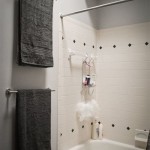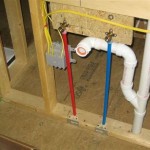```html
How To Install A Pedestal Bathroom Sink
Installing a pedestal bathroom sink can significantly enhance the aesthetics of a bathroom, offering a clean and classic design. This article provides a comprehensive guide to safely and effectively installing a pedestal sink, covering the necessary tools, preparation steps, and detailed installation procedures. Prior preparation and careful execution are crucial for a successful and long-lasting installation.
Before initiating the installation process, ensure the water supply to the bathroom is shut off. Locate the shut-off valves for both the hot and cold water lines; these are typically located under the existing sink or in an adjacent utility area. Turn the valves clockwise until they are fully closed. If the valves are old or corroded and cannot be reliably shut off, it may be necessary to shut off the main water supply to the entire house. After shutting off the water, open the existing faucet to relieve any residual pressure in the pipes.
Next, disconnect the existing plumbing. Place a bucket under the supply lines to catch any remaining water. Use adjustable wrenches to loosen and disconnect the supply lines from the faucet tailpieces. Similarly, disconnect the drainpipe from the sink drain. This typically involves loosening a slip nut on the P-trap. Be prepared for some wastewater to spill, and have rags available for cleanup. Once the plumbing is disconnected, carefully remove the old sink from its mounting location. Depending on how the old sink was installed, it may be caulked to the countertop or wall. Use a utility knife to carefully cut through the caulk before attempting to lift the sink. If the sink is heavy, obtain assistance to prevent injuries.
With the old sink removed, assess the existing plumbing and wall condition. Check the drainpipe and supply lines for any signs of corrosion or damage. Replace any damaged components to ensure a leak-free installation. Also, inspect the wall behind the sink for any signs of water damage or mold. If any issues are found, address them before proceeding with the new sink installation. This might involve repairing drywall, replacing plumbing lines, or treating mold.
Key Point 1: Preparing the Mounting Area
Proper preparation of the mounting area is paramount for a stable and secure pedestal sink installation. This involves marking the location of the sink and installing any necessary mounting hardware.
Carefully unpack the new pedestal sink and inventory all the components. Familiarize yourself with the installation instructions provided by the manufacturer, as specific steps may vary depending on the sink model. Most pedestal sinks consist of two main parts: the sink basin and the pedestal base.
Position the sink basin against the wall in the desired location. Use a level to ensure the sink is perfectly horizontal. With the sink in place, mark the location of the faucet holes and the drain opening on the wall. Using a pencil, trace the outline of the sink basin on the wall. This outline will serve as a guide for installing the mounting hardware.
Pedestal sinks are typically secured to the wall using mounting bolts or brackets. Locate the mounting holes on the back of the sink basin. Transfer these hole locations to the wall within the traced outline. Use a stud finder to determine if any of the mounting holes align with wall studs. If so, you can directly screw the mounting bolts into the studs for a secure connection. If not, you will need to use wall anchors to provide adequate support.
For mounting holes that do not align with studs, drill pilot holes into the wall at the marked locations. Insert appropriate wall anchors into the pilot holes. The type of wall anchor will depend on the wall material (drywall, plaster, etc.) and the weight of the sink. Toggle bolts or heavy-duty plastic anchors are generally suitable for pedestal sinks. Follow the manufacturer's instructions for installing the wall anchors.
Once the wall anchors are in place, install the mounting bolts or brackets. Ensure they are securely fastened to the wall and can adequately support the weight of the sink basin. Before proceeding, double-check the alignment of the mounting hardware with the sink basin. It's easier to make adjustments at this stage rather than after the sink is partially installed.
Key Point 2: Installing the Faucet and Drain
Installing the faucet and drain assembly before mounting the sink basin to the wall offers greater accessibility and ease of installation. This prevents awkward maneuvering in a confined space.
Follow the manufacturer's instructions for installing the faucet. Typically, this involves inserting the faucet tailpieces through the holes in the sink basin and securing them from underneath with mounting nuts and washers. Ensure the faucet is properly aligned and tightened according to the manufacturer's specifications.
Connect the supply lines to the faucet tailpieces. Use Teflon tape on the threaded connections to prevent leaks. Tighten the connections with adjustable wrenches, being careful not to overtighten, which could damage the faucet or supply lines.
Install the drain assembly into the sink basin. This typically involves inserting the drain flange from the top of the sink and securing it from underneath with a rubber gasket, a cardboard washer, and a locknut. Tighten the locknut until the drain flange is snug against the sink basin. Avoid overtightening, as this could crack the sink.
Connect the tailpiece to the drain assembly. The tailpiece is a short pipe that extends from the bottom of the drain assembly. Use Teflon tape on the threaded connection and tighten with an adjustable wrench. Attach the pop-up drain lever to the drain assembly. This lever controls the opening and closing of the drain plug.
Test the faucet and drain for leaks. Turn on the water supply briefly and check for any drips or leaks around the faucet connections and the drain assembly. Tighten any connections that are leaking. Also, test the pop-up drain mechanism to ensure it functions properly.
Key Point 3: Mounting the Sink Basin and Pedestal
The final step involves mounting the sink basin to the wall and installing the pedestal base. Accurate alignment is crucial for a stable and aesthetically pleasing installation.
Carefully lift the sink basin and align the mounting holes on the back with the mounting bolts or brackets on the wall. Gently push the sink basin onto the mounting hardware until it is securely in place. Secure the sink basin by tightening the mounting bolts or brackets. Do not overtighten, as this could crack the sink. Ensure the sink is level and stable before proceeding.
Position the pedestal base under the sink basin. The pedestal base provides additional support and conceals the plumbing. Align the pedestal base with the sink basin and ensure it is level. Some pedestal sinks have mounting holes on the base that align with corresponding holes on the floor. If so, secure the pedestal base to the floor using appropriate screws or bolts. This will provide additional stability and prevent the pedestal from shifting.
Connect the drainpipe to the P-trap. The P-trap is a curved pipe that traps water and prevents sewer gases from entering the bathroom. Use slip nuts to connect the drainpipe to the P-trap and tighten with adjustable wrenches. Ensure the connections are secure and leak-free.
Connect the supply lines to the shut-off valves. Use flexible supply lines to connect the faucet tailpieces to the shut-off valves on the wall. Ensure the supply lines are long enough to reach the valves without being stretched or kinked. Use Teflon tape on the threaded connections and tighten with adjustable wrenches. Ensure the connections are secure and leak-free.
Turn on the water supply and check for leaks. Slowly open the shut-off valves and check for any leaks around the plumbing connections. Tighten any connections that are leaking. Also, test the faucet and drain to ensure they function properly. Run water into the sink and check for leaks around the drain assembly and the P-trap. If any leaks are found, address them immediately to prevent water damage.
Apply a bead of caulk around the perimeter of the sink basin where it meets the wall. This will seal the gap and prevent water from seeping behind the sink. Use a mildew-resistant caulk to prevent mold growth. Smooth the caulk with a wet finger or a caulking tool for a clean and professional finish.
Clean up any debris or spills from the installation process. Remove any tools or materials from the bathroom. Inspect the installation one last time to ensure everything is properly aligned and secure. The new pedestal sink is now installed and ready for use.
```
Here S How Install A Bathroom Pedestal Sink

How To Install A Pedestal Sink W Detailed Pictures Bestlife52

How To Fit A Bathroom Sink Diy Guides Victorian Plumbing

Simple Ways To Install A Pedestal Sink 12 Steps With Pictures

How To Install A Pedestal Sink Elevate Your Bathroom

How To Install A Pedestal Sink And Faucet By Home Repair Tutor

How To Install A Bathroom Sink Or Basin Victoriaplum Com

Simple Ways To Install A Pedestal Sink 12 Steps With Pictures

How To Install A Pedestal Sink Elevate Your Bathroom

How To Install A Pedestal Sink The Home Depot
Related Posts







